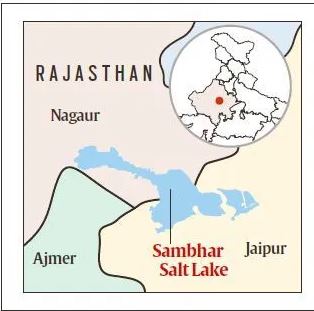Avian Botulism at Sambhar Lake | 22 Nov 2019
Why in News
The Indian Veterinary Research Institute (IVRI), Uttar Pradesh has confirmed avian botulism as the reason for mass mortality of birds, at Sambhar Lake in Rajasthan.
Avian Botulism
- The avian botulism is a neuro-muscular illness caused by Botulinum (natural toxin) that is produced by a bacteria — Clostridium botulinum.
- The bacteria is commonly found in the soil, rivers, and seawater. It affects both humans and animals.
- The bacteria also need anaerobic (absence of oxygen) conditions and do not grow in acidic conditions.
- It affects the nervous system of birds, leading to paralysis in their legs and wings.
- The outbreaks of avian botulism tend to occur when average temperatures are above 21 degrees celsius, and during droughts.
- The Sambhar Salt Lake is India's largest inland saltwater body located near Jaipur in Rajasthan.
- The lake is surrounded on all sides by the Aravali hills.
- It is the source of most of Rajasthan's salt production.
- Sambhar has been designated as a Ramsar site (recognized wetland of international importance) because the wetland is a key wintering area for tens of thousands of flamingos and other birds that migrate from northern Asia.
Mass Mortality at Sambhar Lake
- The possible causes for avian botulism at Sambhar lake are:
- Reduced water levels: This might have increased salinity levels leading to the death of living organisms.
- The decaying plant or animal materials are capable of hosting the bacteria for a longer period of time.
- A bird-to-bird cycle: Since only insectivorous and omnivorous birds were affected and not herbivores, the birds feeding on dead birds could have been a possible cause of such mortality.
- Reduced water levels: This might have increased salinity levels leading to the death of living organisms.
- The possibility of external factors like water pollution and eutrophication are ruled out as no farming is being carried out in the vicinity of sambhar lake.
Way Forward
- Sambhar Lake is not the first instance where deaths due to botulism have been recorded. 7,000 water birds died in Lake Michigan in 2007 and 2008. In Hawaii, the toxin killed around 183 Laysan Ducks in 2008.
- The botulism outbreaks are likely to become more frequent as climate change alters wetland conditions to favour bacteria and pathogens.
- Thus, the establishment of rescue and medical centres along with the mitigation of climate change need to be considered by the government as a precautionary measure for the future.

